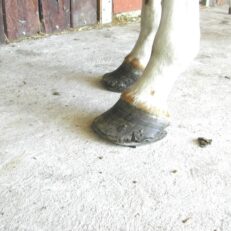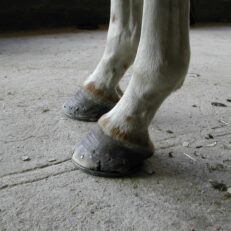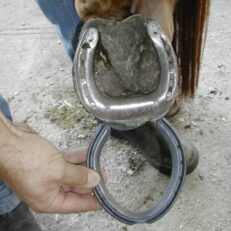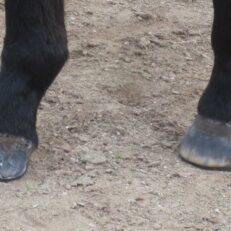A recent incident resulted in this article. The complaint from the owner was that the horse had become very unstable on its feet, was tripping and stumbling, and very rough to ride but had previously not been like this. On inspecting the horse, I found it was shod totally inappropriately with square toed shoes all round. The danger seems to be that although this is a supposedly new fashioned idea the real answer to the problem is in the balance of the foot. If the hoof is prepared and balanced in the correct fashion, the ground surface of the hoof should be exactly the same shape as the coronary band. However the square toed shoes tend to promote flares either side of the square toed shoe (Pic 1)
If you want an idea of what flares do to these feet, push your own thumb nail down on a hard surface of a table, and you will notice that about half way up you will see a red spot – a stress point in your fingernail which causes pain. The horse’s hoof reacts in exactly the same way. If it is long and flared (Pic 1) that horse is unquestionably suffering a lot of pain half way up that hoof capsule, and this is why these horses get unkind to ride, become unstable and do not want to work. As soon as you relieve these stress points and get the hoof capsule to come down at the correct angle, you will relieve this pain. It needs to be understood that this really IS pain – you can’t see the red spots in most black hoofs; it can be seen occasionally in white feet, but even if it can’t be seen it is still there and is very very painful.
If you refer again to Pic 1 you will also see the heels of these shoes hanging out past the buttress of the heel – this creates pressure back there and will cause those heels to collapse. It is the most illogical fitting shoe I have ever seen. The heel of the shoe must finish at the buttress of the heel otherwise if it is hanging out the back it will create pressure. It is only natural that a long extension hanging out the back is a bit like wearing skis all the time. Make no mistake, extended heels will cause pressure at the heel.
Pic 2 shows the same horse after reshoeing correctly to the hoof’s natural shape, and Pic 3 shows the comparison of the square toed shoe and the correct shoe once the hoof is trimmed properly. As you can see, it is a bit like chalk and cheese.
Over 49 years of shoeing horses, I always expected that owners had the capacity to maintain their horse’s feet or at least have a pretty fair understanding of what was required for shoeing and trimming for performance. All that seems to have gone by the board, and owners are being led to believe that below the knee of the horse is some mysterious realm of the farrier. I still believe it is the owner’s responsibility to seek information and take more of an interest in how their horse is being looked after at hoof level. It is not rocket science, it is very, very easy to learn and to understand, and primarily the first responsibility is for horse owners and riders to thereby be able to then have a positive input into the hoof care of their horses.
If your horse is tripping and stumbling and becoming unstable on his feet, the chances are pretty high that he is just simply too long in the toes. If you then check the hoof pastern angle from the side, and you find that is right then the answer lies not in just squaring that toe off as the modern trends seems to be, but simply to balance the hoof properly, trim it correctly, and shape it as per the horse’s coronary band.
The misunderstanding that horses in the wild wear their toes square is true only in one sense – at the end of a drought when the springs have all dried up and the horses have to dig for water, they wear their toes down so that they do become square. However as soon as the season breaks their feet grow, they wear off and their toe grows down in the same shape as the coronary band. The answer is NOT in putting on square toed shoes.
If your horse is unstable, the answer is simply to balance the hoof properly and shape the hoof as per the coronary band.




